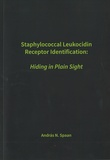Staphylococcal Leukocidin Receptor Identification
Hiding in Plain Sight
Summary
Staphylococcus aureus is a leading cause of bacterial infections in humans worldwide. A key host defense strategy against S. aureus is phagocyte-mediated killing. In return, a major mechanism deployed by S. aureus to target host phagocytes is the production of cytolytic toxins. Staphylococcal leukocidins comprise a class of bicomponent pore-forming toxins capable of damaging the host cell plasma membrane. The leukocidins characterized from human S. aureus isolates include Panton-Valentine Leukocidin LukSF (PVL), γ-Hemolysin (HlgAB and HlgCB), LukED and LukAB. Staphylococcal leukocidins show cell and species-dependent specificity towards immune cells. The contribution of leukocidins towards pathophysiology, and their potential as vaccine or drug targets in staphylococcal disease is poorly understood. This thesis describes the identification of the proteinaceous receptors of the major leukocidins PVL, HlgAB, and HlgCB. All identified receptors belong to the family of complement and chemokine receptors. Expression and interspecies variations of the involved receptors define cellular and species specificity of the toxins. The findings allow, for the first time, to appreciate the contribution of the leukocidins to staphylococcal virulence. This thesis paves the way for the development of improved preclinical models for infection, which is a prerequisite for the development of new therapeutics and an effective vaccine.
